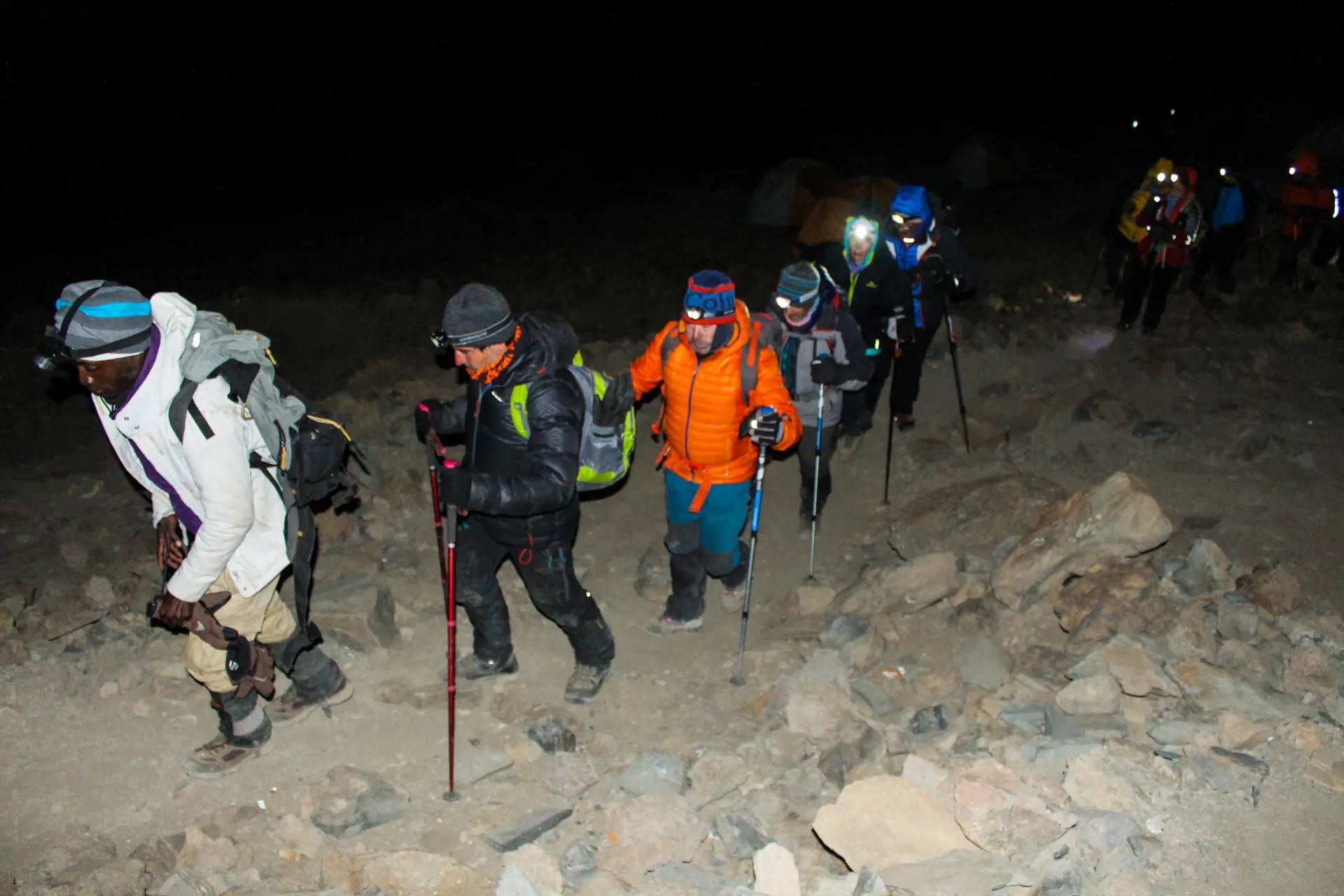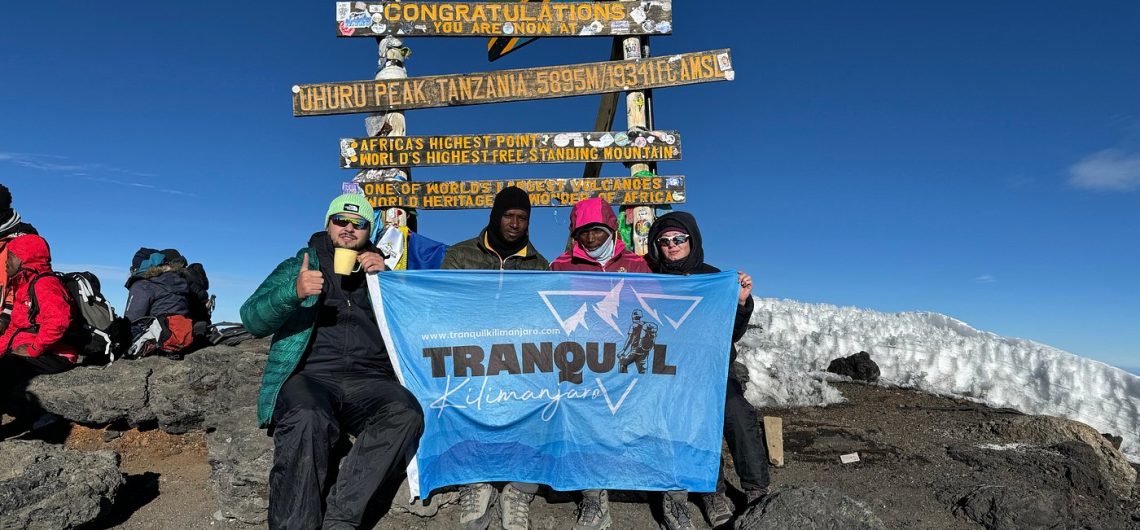The right gear will keep you warm on the summit of Kilimanjaro, whether it is the final push to the summit at night or when you are standing at the top of Kilimanjaro, Uhuru Peak enjoying the sunrise and taking selfies despite the harsh weather, what you wear is key! You should “likely” wear all of your main layers at this point, but keep an eye on the weather and conditions. People say Kilimanjaro is the easiest of the seven summits but let me bust your bubbles, the summit night is not a piece of cake because you will begin your summit journey at around midnight, and it will be very cold up there. You should wear your base (thermal) layer on top and bottom in extremely cold weather. You can wear one heavier pair of pants and a pair of waterproof pants as your outer layer, or you can wear two pairs of thin pants on top of your leggings. The same goes for the top layer, where you should have many thinner mid-layers (long sleeve t-shirts, trek shirts, mid-layer fleeces), a thick fleece, and a waterproof jacket over that, or a down or synthetic fill jacket instead. Next, put on your boots, thick, clean socks, a balaclava in case of wind, a warm cap or scarf, and gloves (both inner and outer pairs) for your extremities. Heat can also be added by gaiters. Some folks bring hand warmers as well. If it’s extremely cold, remember to walk with your toes wiggled to keep your blood flowing!
See and download our recommended gear list for Kilimanjaro
Since each person reacts to the conditions of the mountain differently, the secret to dressing appropriately for Kilimanjaro is to control your own climate by dressing according to how “you” feel and the state of the environment around you. On any day of the walk, you’ll notice that your body will warm up from exercise while you walk, therefore it’s critical to control your body temperature to avoid being too hot or too cold. The simplest method to accomplish this is to make sure you are wearing the appropriate number of layers for the weather. If not add or remove a layer so that you’re comfortable. You’ll get heated while walking, so open up your jacket and mid-layer to let some fresh air in. The heat will remain inside when you pull the zips up to take a break. This is especially crucial if you’re in an exposed area if it’s windy outside.
Your guide will brief you each evening so that you may prepare the appropriate equipment for the next day. If you have any questions, don’t hesitate to ask. If you have everything you need in your day bag, it’s really simple to adjust your attire so you’re never too hot or too cold.
That’s all there is to dressing appropriately! There are no hard and fast rules, just make sure you have what’s on the equipment list and that’ll offer you the freedom to be adaptive to the weather and most importantly dry and comfortable.

Summit night on Mount Kilimanjaro is not only the climax of your climb but also the most challenging due to the extreme weather conditions and the physical demands of ascending in the dark. Here’s a detailed guide on what you’ll need to wear from head to toe to ensure a safe and comfortable summit attempt:
Head Gear
For summit night and the peak, it’s crucial to keep your head warm and protected from the elements. A balaclava provides full coverage for your face, head, and neck, but if it feels too restrictive, you can pair a neck gaiter with a beanie that covers your ears. Don’t forget a head torch to help navigate in the dark, and polarized sunglasses or ski goggles to shield your eyes from glare and UV rays. Apply lip balm and sunscreen to protect against cold winds and strong sunlight.
- Balaclava: Essential for comprehensive warmth, covering your face, head, and neck where typical scarves might fall short. If a balaclava feels too constricting, consider a neck gaiter paired with a beanie that has ear flaps.
- Beanie: A snug fit is crucial to keep your head warm. A beanie with ear flaps can serve as an alternative if you’re not wearing a balaclava.
- Head Torch: A necessity for navigating in the dark, with a strong beam and adjustable straps for comfort over hats and balaclavas. A top band can prevent it from slipping.
- Sunglasses or Ski Goggles: Protect your eyes from snow glare and UV rays at high altitudes. Polarized sunglasses are recommended.
- Lip Balm & Sunscreen: Protect your lips and face from the harsh cold, wind, and sun. Choose products with high SPF for the intense sunlight at altitude.
Upper Body Attire
Layering is key for warmth and flexibility. Start with a moisture-wicking compression top to keep sweat off your skin, followed by a long-sleeved thermal top for insulation. A softshell jacket made from fleece provides warmth without bulk, and top it off with a waterproof, breathable jacket to guard against wind and moisture. For extra warmth, especially at the summit, an insulated down or synthetic jacket is essential.
- Moisture-Wicking Compression Top: This base layer should be snug, wicking away sweat to keep you dry. Ensure it’s tucked into your pants to seal in warmth.
- Long-Sleeved Thermal Top: Over the compression top, another snug layer for insulation.
- Softshell Jacket: Preferably a fleece jacket for its insulating properties without the bulk of a lined jacket.
- Waterproof, Breathable Jacket: With a hood to shield against wind and precipitation, ideally with a drawstring for a tight fit around the face.
- Insulated Down or Synthetic Jacket: A critical layer for warmth. If buying isn’t an option, consider renting one.
Hand Protection
Your hands need serious warmth to avoid frostbite. Begin with inner gloves that fit snugly, then add thermal gloves for regular use. For summit night, ski mittens are recommended, as they provide better heat retention than regular gloves. Make sure the mittens are easy to manage even with cold, stiff fingers.
- Inner Gloves: Thin, snug gloves for basic warmth, possibly fingerless for dexterity.
- Thermal Gloves: For everyday use on the climb, these should be comfortable and warm.
- Ski Mittens: Preferable to gloves for the summit due to better heat retention. Look for ones easy to manage with cold fingers.
Leg Wear
For your lower body, start with moisture-wicking leggings as your base layer, followed by thermal leggings for added insulation. Wear waterproof hiking pants throughout the trek, and add fleece pants over them for summit night. Consider wearing gaiters to keep debris out of your boots and add warmth to your ankles.
- Moisture-Wicking Leggings: A base layer for your legs, similar to cycling tights.
- Thermal Leggings: An additional thermal layer for increased warmth.
- Waterproof Hiking Pants: Your standard hiking pants, worn throughout the trek.
- Fleece Pants: An extra outer layer for summit night, easy to remove if you become too warm.
- Gaiters: Useful for keeping scree out of your boots and adding a bit of warmth around the ankles.
Footwear
Comfortable, sturdy hiking boots are essential for summit night, and they should be water-resistant and broken in. Layer your socks with sock liners to reduce friction and manage sweat, then wear thermal socks for insulation. Make sure your boots fit comfortably with these layers.
- Hiking Boots: Well-broken-in, water-resistant boots are vital. Ensure they accommodate your sock layers comfortably.
- Sock Liners: Thin, moisture-wicking socks to reduce friction and manage sweat.
- Thermal Socks: Thick, warm socks to keep your feet insulated. Ensure they fit well with boots without being too tight.
General Tips on what to wear at the peak
- Avoid New Gear: Everything you wear on summit night should have been worn or tested beforehand to avoid discomfort or unexpected issues like Tash’s experience with ill-fitting leggings.
- Adaptability: Be prepared to adjust your layers. Conditions can change rapidly, and your ability to quickly add or remove clothing is key to regulating body temperature.
Climbing Kilimanjaro, especially reaching the summit, requires careful preparation regarding your attire. Every piece of clothing has a role in protecting you against the elements, ensuring you can focus on the climb itself. Remember, summit night isn’t just about enduring the cold; it’s about being equipped to enjoy the journey to the top.
- The Ultimate Kilimanjaro Climbing Gear Recommendations Checklist
- Mount Kenya Gear List
- Mount Meru Gear List
- Why headlamps are important for Kilimanjaro treks especially on summit night
- Northern Circuit Summit Success Rate ; Best summit success rate
- Lemosho Route Summit Success Rate
- What to expect on summit night when you climb Kilimanjaro
- Summit Night, Kilimanjaro
- Why do people climb Mount Kilimanjaro at night?
![]()

